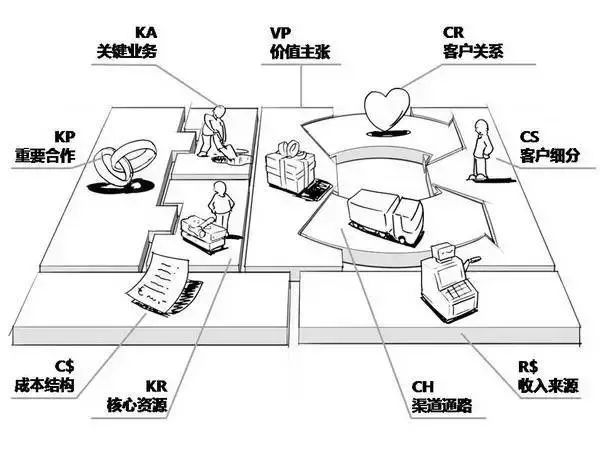Introduction:
- The Business Model Canvas (BMC), first developed by Osterwalder et al. (2010), is a simple yet effective visual strategy tool that organizations, big and small, use for business model innovation. The BMC provides the basis for the Lean Canvas approach used in Lean start ups with its emphasis on entrepreneur-focused business planning.
- The importance of the organization’s business model in the context of strategy and innovation is very key. Business models, if incorrectly defined and not supporting the innovation strategy and management, the technology strategy, and the product strategy, will not achieve the goal of value creation — which is ultimately what it’s all about for profit-making organizations. The growth of the Internet, the ease of accessibility and globalization (among others) have created the impetus for organizations to incorporate innovation into every facet where value can be captured and translated into profit.
Finally, “technological innovation does not guarantee business success — new product innovation efforts should be coupled with a business model defining their ‘go to market’ and ‘capturing value’ strategies.” (Treece, 2010:183)
The BMC normally addresses customer segments, value propositions, channels, customer relationships, revenue streams, and key activities, resources, partners, and cost structures. A key component of the BMC is the aforementioned aspects of knowledge in a visual form, similar to Figure 1.8. It is designed to depict an entire business model on a single page. The right side of the BMC focuses on the customer, while the left side focuses on the business. The information is derived from asking and answering key questions:
Business Model Canvas
| ⑨ Key Partners •Who are key partners? •Who are key suppliers? •Which key resources are we acquiring from partners? •Which key activities do partners perform? |
⑧ Key Activities •What key activities do our value proposition require? •Our distribution channels? •Customer relationships? •Revenue streams? |
② Value Propositions •What value do we deliver to the customer? •Which customer problems are we solving? •What products and services are we offering to each customer segment? •Which customer needs are we satisfying? Features Advantage Experience Pains Solutions Customers ‘jobs |
⑤ Customer Relationship •What type of relationship is expected by each customer segment? •Which ones are established? •How are these integrated into our overall business model? •How costly are they? |
① Customer Segments •For who are we creating value? •Who are our most important customers? Mass market Niche market Segmented Diversified |
|
|---|---|---|---|---|---|
| ⑥ Key Resources •What key resources do our value propositions, distribution channels, customer relationships, revenue streams require? Physical Intellectual Human Financial |
③ Channels •Through which channels do our customers want to be reached? •How are we now reaching them? •How are our channels integrated? •Which ones are most cost efficient? |
||||
| ⑦ Cost Structure •What are the most important costs inherent in our business model? •Which key resources are most expensive? •Which key activities are most expensive? |
④ Revenue Stream •What value are our customers really willing to pay? •What are they currently paying? •What would they prefer to pay? •How much does each revenue stream contribute to total revenue? |
Defintion:
① Customer segments
An organization often focuses on a broad range of customers. These can be divided into distinct customer segments, each with its own specific needs and requirements. This allows for tailoring of specific value propositions, customer relationships and channels for each segment.
② Value propositions
The value proposition defines how an organization distinguishes itself from the competition. This distinction focuses on quantity such as price, service, speed, and delivery conditions on the one hand, and on the other hand it also focuses on quality including design, brand status, and customer experience and satisfaction.
③ Channels
Which channels are to be focused on to reach the desired customer segments? How are those channels integrated? Which are most cost-effective?
④ Revenue streams
What are the customers willing to pay and for what value? How would they prefer to pay? How are they currently paying? How does each stream add up to the total revenue?
⑤ Customer relationships
What type of relationship is required for each customer segment? What are the expectations of these customers? How are they established? What would be the associated costs?
⑥ Key resources
Resources can be categorized as physical, intellectual, financial, or human resources. Physical resources may include assets such as business equipment. Intellectual resources include (among other things) knowledge, brands, and patents.
⑦ Cost structure
What are the most important cost drivers in the organization’s business model? Which key resources and activities are most expensive? The business can be either cost-driven or value -driven. A cost-driven organization looks to minimize all costs while a value-driven company is more focused on delivering great customer value in terms of quality or prestige.
⑧ Key activities
What key activities are required to successfully deliver the value proposition? These include R&D, marketing, manufacturing, and distribution channels.
⑨ Key partners
Who are the key partners? Key suppliers? Which key resources are they providing? Which key activities do the partners perform? Key partners are the external companies or suppliers needed by the business to perform key activities and deliver value to the customers. Buyer- relationships are necessary to optimize operations and reduce the risks associated with a business.
翻译:
| ⑨ 重要伙伴 •谁是主要合作伙伴? •谁是主要供应商? •我们从合作伙伴那里获取哪些关键资源? •合作伙伴执行哪些关键活动? |
⑧ 关键业务 •我们的价值主张需要什么关键活动? •我们的分销渠道? •客户关系? •收入来源? |
② 价值主张 •我们为客户提供什么样的价值? •我们正在解决哪些客户问题? •我们为每个细分客户提供什么产品和服务? •我们满足哪些客户需求? 特性 优势 体验 痛点 方案 客户的工作 |
⑤ 客户关系 •每个客户群体希望建立什么样的关系? •哪些是确定的? •如何将这些整合到我们的整体商业模式中? •它们有多贵? |
① 客户细分 •我们为谁创造价值? •谁是我们最重要的客户? 宽泛市场 利基市场 细分的市场 多元化的市场 |
|
|---|---|---|---|---|---|
| ⑥ 核心资源 •我们的价值主张、分销渠道、客户关系和收入流需要哪些关键资源? 物理的 专利 人力资源 资金 |
③ 渠道通路 •我们希望通过哪些渠道接触到我们的客户? •我们现在如何与他们取得联系? •我们的渠道是如何整合的? •哪些是最具成本效益的? |
||||
| ⑦ 成本构成 •我们的商业模式中最重要的固有成本是什么? •哪些关键资源是最昂贵的? •哪些关键活动是最昂贵的? |
④ 收入来源 •我们的客户真正愿意支付的价值是什么? •他们现在付多少钱? •他们更愿意付多少钱? •每个收入流对总收入的贡献是多少? |
定义:
① 客户细分
组织通常关注广泛的客户。这些可以分为不同的客户群,每个客户群都有自己的特定需求和要求。这允许为每个细分市场定制特定的价值主张,客户关系和渠道。
② 价值主张 ★★★
价值主张定义了组织如何从竞争中脱颖而出。这种区别一方面侧重于价格,服务,速度和交货条件等数量,另一方面还侧重于质量,包括设计,品牌地位以及客户体验和满意度。
③ 渠道通道
要关注哪些渠道才能覆盖所需的客户群?这些渠道是如何整合的?哪些最具成本效益?
④ 收入来源
客户愿意支付什么费用,价值何在?他们更愿意如何支付?他们目前如何付款?每个流如何加起来增加总收入?
⑤ 客户关系
每个客户群需要什么类型的关系?这些客户的期望是什么?它们是如何建立的?相关成本是多少?
⑥ 核心资源:
资源可以分为物理、智力、财务或人力资源。物理资源可能包括业务设备等资产。智力资源包括(除其他事项外)知识,品牌和专利。
⑦ 成本结构
组织业务模型中最重要的成本驱动因素是什么?哪些关键资源和活动最昂贵?业务可以是成本驱动的,也可以是价值 驱动的。成本驱动的组织希望最大限度地降低所有成本,而价值驱动的公司则更专注于在质量或声望方面提供巨大的客户价值。
⑧ 关键业务
成功交付价值主张需要哪些关键活动?这些包括研发,营销,制造和分销渠道。
⑨ 重要伙伴
谁是主要合作伙伴?主要供应商?他们提供了哪些关键资源?合作伙伴执行哪些关键活动?关键合作伙伴是企业执行关键活动和为客户提供价值所需的外部公司或供应商。买方关系对于优化运营和降低与业务相关的风险是必要的。


